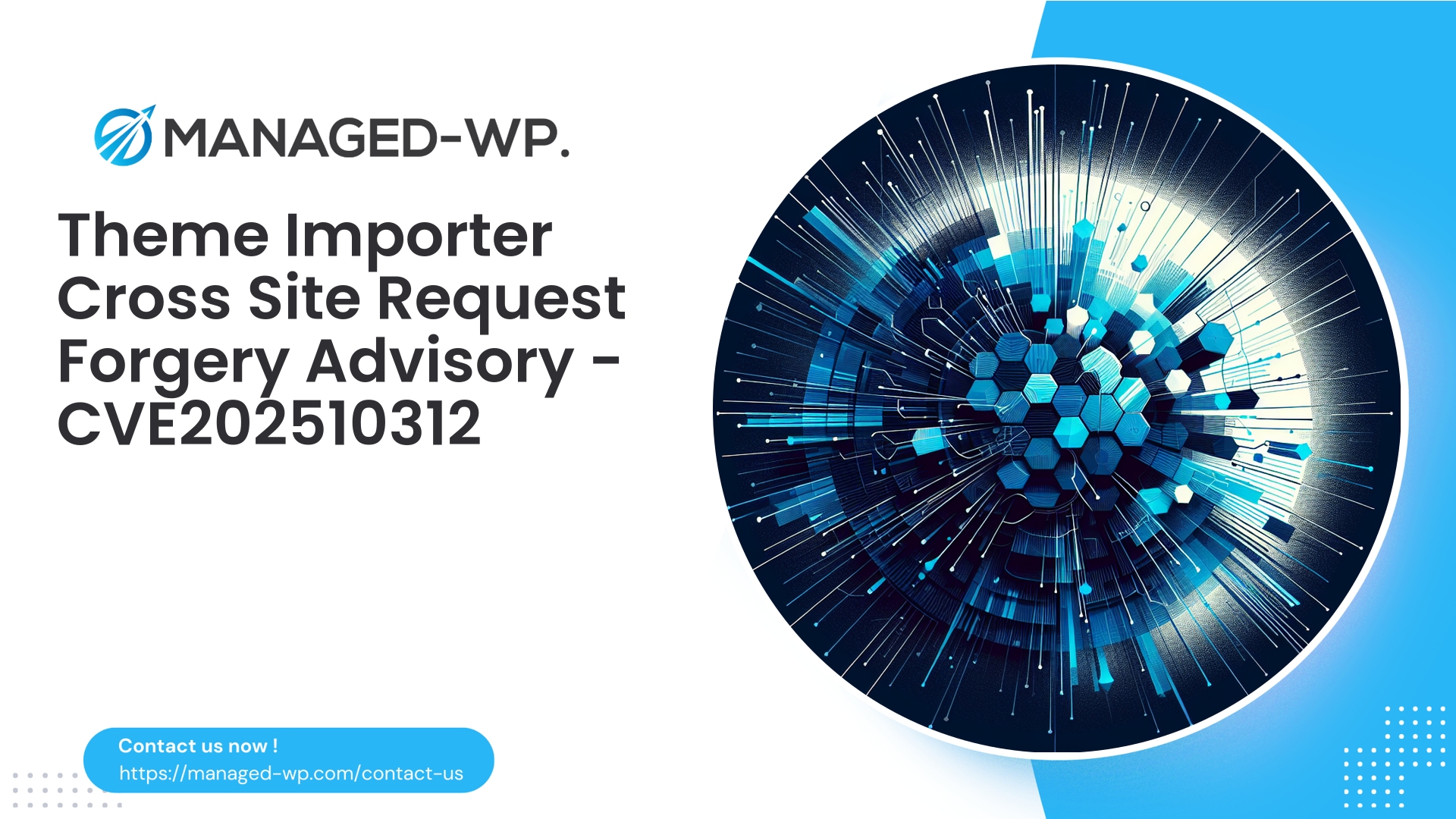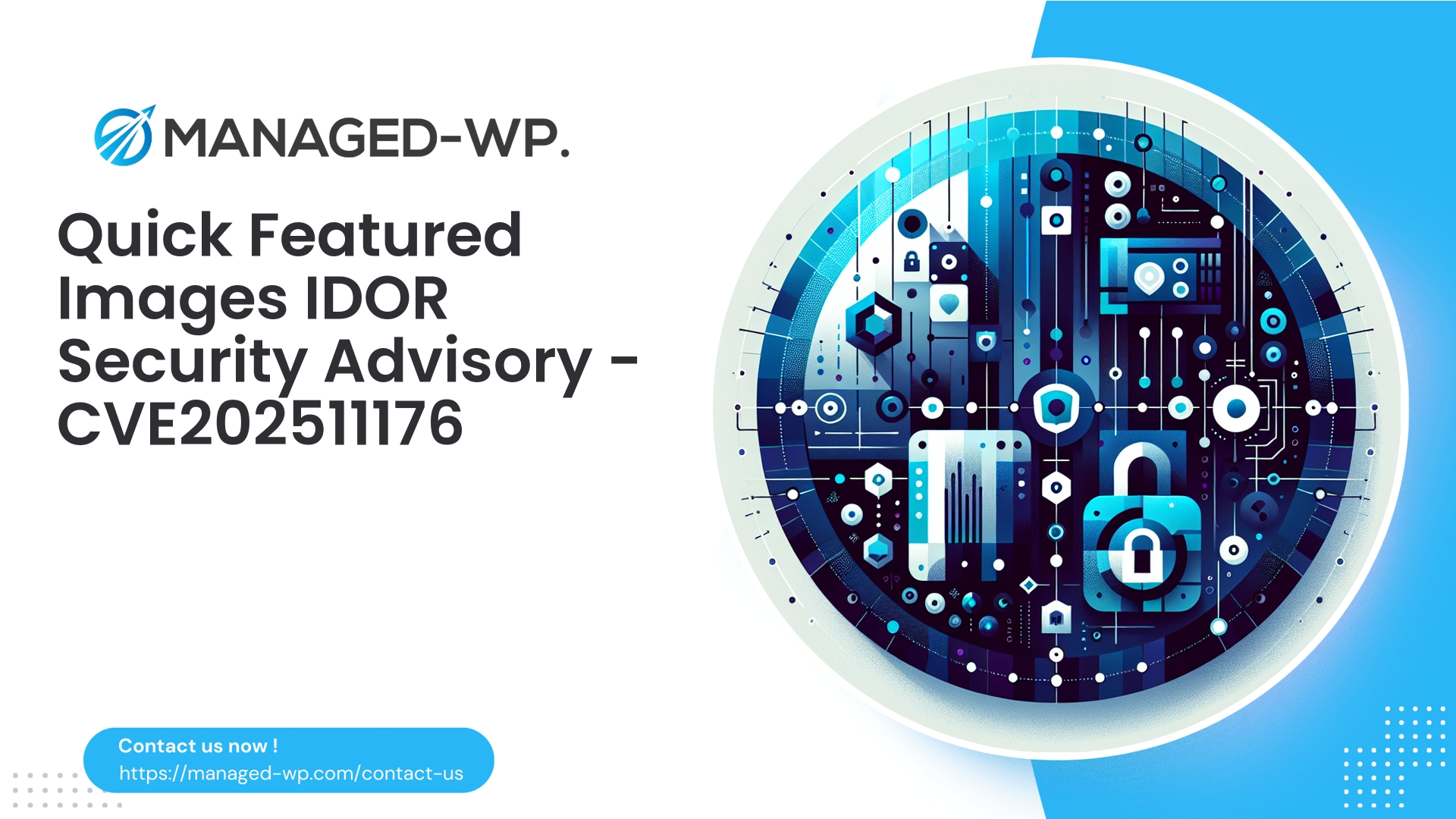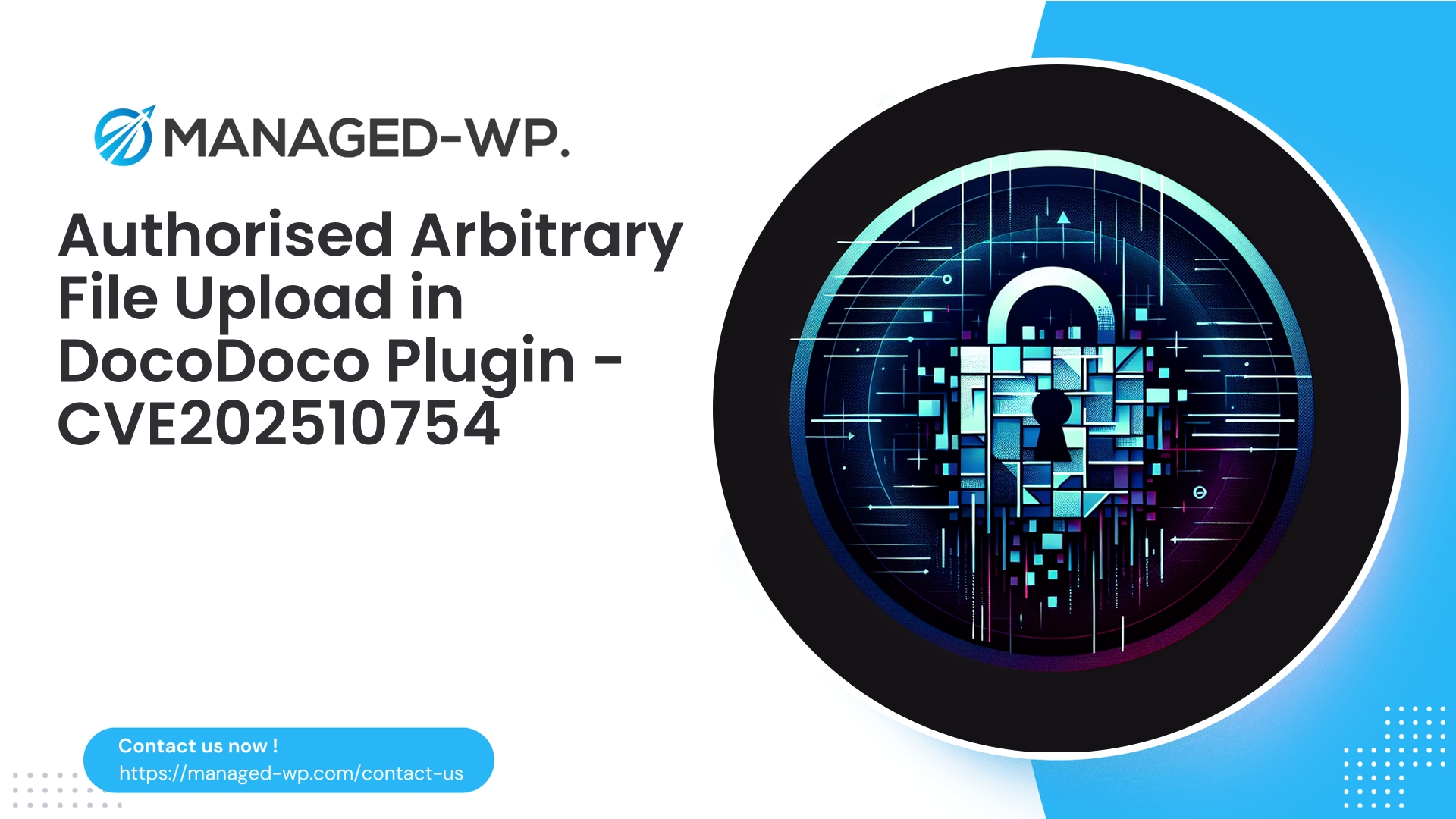| 插件名稱 | 主題導入器 |
|---|---|
| 漏洞類型 | CSRF(跨站請求偽造) |
| CVE編號 | CVE-2025-10312 |
| 緊急 | 低的 |
| CVE 發布日期 | 2025-10-15 |
| 來源網址 | CVE-2025-10312 |
主題導入器(≤ 1.0)— CSRF 漏洞(CVE-2025-10312):WordPress 網站所有者應立即採取的措施
執行摘要: 影響 WordPress 主題導入器外掛程式 1.0 及以下版本的跨站請求偽造 (CSRF) 漏洞已公開揭露,漏洞編號為 CVE-2025-10312。此漏洞允許攻擊者利用已認證的管理員或特權使用者會話執行未經授權的操作,例如匯入主題或修改關鍵網站配置。儘管其 CVSS 評分看似較低(4.3),但會話濫用和狀態篡改的風險仍然很高。本報告由 Managed-WP 的安全專家發布,全面分析了漏洞的技術細節、實際攻擊場景、偵測策略、遏制建議,以及託管式 Web 應用防火牆 (WAF) 解決方案如何在官方更新發布前提供有效的虛擬修補程式。
免責聲明: 此分析和指導由 WordPress 安全領域的權威領導者 Managed-WP 提供。內容面向尋求快速可靠的緩解技術的網站所有者、開發人員、網站託管商和安全團隊。
為什麼必須立即解決「低」嚴重性 CSRF 問題?
CVSS評分4.3通常會降低使用者感知到的風險。然而,CSRF攻擊利用了網站對已認證使用者的信任,並可能導致嚴重的後果:
- 攻擊者誘騙已登入使用者(通常是管理員)在不知情的情況下執行改變系統狀態的操作,方法是讓他們的瀏覽器提交惡意請求。
- 潛在後果包括匯入不受信任的主題、部署後門或更改關鍵網站設置,可能導致進一步的入侵。
- WordPress 網站通常有多位管理員和編輯,他們可能會在登入狀態下不知不覺地造訪不安全的網站,從而大大增加攻擊面。
鑑於該漏洞已公開披露且缺乏官方補救措施,及時採取行動至關重要。
了解 CSRF 的工作原理以及此插件為何存在漏洞
CSRF(跨站請求偽造)是指網站在未驗證請求來源或未確保其來自授權使用者介面的情況下接受狀態變更請求。 WordPress 使用 nonce 令牌和引用頁驗證來緩解 CSRF 攻擊,但 Theme Importer 外掛程式 1.0 及更早版本未能正確實施這些保護措施。
具體來說:
- 攻擊者精心製作一個網頁,該網頁會靜默地向插件的主題匯入端點(例如,)提交 POST 請求。
wp-admin/admin-post.php?action=theme_import或者admin-ajax.php?action=import_theme). - 如果管理員在登入狀態下造訪此惡意頁面,其瀏覽器會自動傳送授權 cookie。
- 由於外掛程式中缺少 nonce 或 referer 檢查,這些請求以管理員權限執行,從而允許未經授權的主題匯入和設定變更。
即使僅限於主題導入,惡意主題也可能嵌入後門或遠端通訊功能,使網站面臨完全被攻破的風險。
真實世界的攻擊場景
-
後門嵌入式主題導入
- 攻擊者強迫管理員匯入包含隱藏後門(例如,嵌入式 PHP)的主題。
函數.php),從而賦予攻擊者持久存取權限。
- 攻擊者強迫管理員匯入包含隱藏後門(例如,嵌入式 PHP)的主題。
-
未被察覺的設定篡改
- 悄悄地更改臨時配置標誌或 URL,以便將來進行攻擊或遠端程式碼執行。
-
未經授權的文件上傳
- 濫用導入器的檔案處理功能,將任意 PHP 檔案上傳到可寫入目錄中。
-
利用連鎖漏洞進行權限提升
- 匯入精心製作的主題,利用其他易受攻擊的外掛程式或錯誤配置來提升攻擊者的權限。
筆記: 攻擊者通常會利用多個低危險漏洞串聯起來,最終實現網站全面入侵。忽視此漏洞可能導致嚴重的安全漏洞。
確認您網站上的漏洞
驗證漏洞狀態:
- 檢查已安裝的插件及其版本
- 進入 wp-admin > 插件,找到「主題導入器」。
- 如果已安裝且版本為 1.0 或更低,則網站有風險。
- 檢查插件端點
- 查看插件文件
wp-content/plugins/theme-importer/尋找管理員操作(例如,admin_post_*,admin_ajax_{action}回調)。
- 查看插件文件
- 檢查隨機數字驗證
- 確保控制導入或設定的功能使用
檢查管理員引用者()或者檢查 Ajax 引用者()缺席表示存在脆弱性。
- 確保控制導入或設定的功能使用
- 審核網站日誌和內容
- 注意不明原因的主題匯入和新文件。
wp-content/themes未經授權的使用者或可疑的 POST 請求。
- 注意不明原因的主題匯入和新文件。
如果無法進行技術審核,請直接採取以下遏制措施。
立即採取遏制措施
如果發現外掛程式版本≤1.0,請立即採取以下措施:
- 啟用維護模式(如果可以)
- 在漏洞活躍期間,盡量減少管理員的風險暴露。
- 停用主題導入插件
- 消除攻擊面的最快方法:wp-admin > 外掛程式 > 停用「主題導入器」。
- 如果停用功能受限,請重新命名插件資料夾
- 使用伺服器 shell 存取權限:
mv wp-content/plugins/theme-importer wp-content/plugins/_theme-importer-disabled
- 使用伺服器 shell 存取權限:
- 輪換所有管理憑證並使會話失效
- 重置所有管理者的強密碼。
- 強制註銷所有活動會話-透過密碼重設、鹽值更新或會話管理插件。
- 盡可能強制執行雙重認證(2FA)。
- 掃描是否有洩漏跡象
- 尋找異常的主題或文件,以及更改
wp_options可疑的定時任務或其他管理員帳號。 - 使用安全掃描器和檔案完整性檢查來識別後門。
- 尋找異常的主題或文件,以及更改
- 應用基於WAF的虛擬補丁
- 啟用託管防火牆規則,阻止外掛程式端點和跨網域 POST 請求到管理 URL。
- 與利害關係人溝通
- 向網站管理員和主機支援團隊通報漏洞及緩解措施狀態。
- 建議暫時避免從不受信任的網路登入 wp-admin。
檢測過程中需要注意的事項
- Web伺服器日誌
- 針對 POST 請求的目標
/wp-admin/admin-ajax.php或者/wp-admin/admin-post.php具有可疑或未知的行為值。 - POST 請求中缺少或存在可疑的 Referer 標頭。
- 來自不常見用戶代理字串或未知 IP 位址的多個 POST 請求。
- 針對 POST 請求的目標
- WordPress資料庫和日誌
- 新增或修改後的主題。
- 意外的管理員使用者帳戶。
- 可疑的
wp_options條目。
- 檔案系統
- 內容經過混淆處理或位於不尋常目錄中的 PHP 檔案。
- 在發布週期之外意外修改的文件。
- 行為異常
- 非計劃的網站重新導向、管理員電子郵件變更或配置變更。
如果偵測到,則將該網站視為已被入侵,並進行全面的取證調查。
開發者指南:修復程式碼中的漏洞
外掛程式作者或開發者應整合強大的反 CSRF 機制和能力驗證:
- 使用
檢查管理員引用者()和檢查 Ajax 引用者()驗證請求:
if ( ! empty( $_POST['theme_importer_nonce'] ) ) { check_admin_referer( 'theme_importer_import', 'theme_importer_nonce' ); } else { wp_die( '安全檢查失敗' ); }
add_action( 'wp_ajax_import_theme', 'ti_import_theme_callback' ); function ti_import_theme_callback() { check_ajax_referer( 'theme_importer_ajax', 'security' );
if ( ! current_user_can( 'activate_plugins' ) ) { wp_die( '權限不足' ); }
- 檢查壓縮檔案內容,是否有未經授權的 PHP 檔案或可疑檔案。
- 限製檔案寫入位置並驗證檔案系統權限。
在修復程式實施之前,停用或虛擬修補仍然是最安全的選擇。
立即保護您的網站:託管式 WordPress WAF 虛擬補丁
Managed-WP 的 Web 應用程式防火牆提供了一個有效的虛擬補丁,可以保護您的網站免受攻擊:
- 跨域 POST 請求阻塞: 防止向沒有有效 WordPress nonce 或 referer 標頭的管理端點發出跨站點 POST 請求。
- 阻止存在漏洞的插件端點: 拒絕針對主題導入器操作的可疑請求,例如
導入主題或者主題導入器導入. - 對關鍵操作強制執行身份驗證: 僅允許來自受信任 IP 位址且帶有適當認證會話 cookie 的請求。
- 檢查文件上傳: 阻止或隔離未經 nonce 驗證的可疑 zip 壓縮檔案上傳。
- 速率限制和信譽檢查: 限制重複的可疑 POST 請求並封鎖已知的惡意 IP 位址。
ModSecurity 規則範例片段:
# 阻止對 admin-ajax.php 的 POST 請求,缺少 nonce 和跨域 Referer。安全規則 REQUEST_URI "@contains /wp-admin/admin-ajax.php" "phase:2,chain,deny,id:100001,log,msg:'CSRF 緩解 - admin-ajax 缺少 nonce'" 安全規則 REQUEST_METHODCSRF 緩解 - admin-ajax 缺少 nonce'" 安全規則&ARGS:security "@eq 0" "t:none" 安全規則 REQUEST_HEADERS:Referer "!@contains example.com"
- 代替
example.com使用您的網站域名。 - 調整 nonce 參數名稱以符合插件實作。
- 在可行的情況下,使用挑戰而不是封鎖來減少誤報。
Managed-WP 可以自動部署客製化的 WAF 規則來保護您的網站,同時最大限度地減少對使用者的干擾。
建議的 WAF 簽章和偵測規則
- 簽名 1: 阻止 POST 請求
wp-admin/admin-ajax.php具有可疑的操作參數和缺失的隨機數。 - 簽名 2: 拒絕 POST 請求
admin-post.php沒有有效的 Referer 標頭。 - 簽名 3: 過濾缺少 nonce 驗證的 zip 檔案上傳,以匯入端點。
- 簽名 4: 封鎖或限制來自自動化用戶代理程式和未知 IP 位址的 POST 請求到管理端點。
- 簽名 5: 對來自相同 IP 位址、指向管理 URL 的重複 POST 請求實施速率限制。
微調規則以適應可信任的內部 IP 位址和已知的員工機器,以避免服務中斷。
事件後處理和恢復檢查清單
- 遏制: 立即停用該插件;如有必要,隔離該網站。
- 根除: 清除所有惡意程式碼和後門,並將受感染的檔案替換為乾淨的版本。
- 恢復: 從已驗證的備份中還原;僅重新安裝已更新、已打補丁的插件。
- 硬化: 強制執行最小權限原則、強密碼、多因素身份驗證和及時更新。
- 經驗教訓: 記錄違規事件的時間軸和補救措施;密切注意未來插件的發布。
- 法律聲明: 評估資料外洩通知要求(如適用)。
預防 CSRF 及類似風險的長期策略
- 開發最佳實務: 始終對任何狀態修改端點使用 nonce 和能力檢查;避免對此類操作處理 GET 請求。
- 操作紀律: 瀏覽未知網站時,請避免使用管理員會話;請使用專用的管理員瀏覽器或設定檔。
- 會話和權限管理: 定期輪換鹽和金鑰;對於關鍵變更,實施帶有重新認證的短期會話。
- 文件系統衛生: 使用最小權限原則;禁止在上傳目錄中直接執行操作。
- 監控和備份: 維護異地備份並定期執行檔案完整性檢查。
Managed-WP 如何增強您的安全態勢
Managed-WP 提供多層防禦措施,以緩解諸如 CVE-2025-10312 之類的漏洞:
- 動態託管WAF規則: 快速部署虛擬補丁,阻止漏洞利用嘗試,無需等待插件更新。
- Nonce 和 Referer 執行: 加強對管理端點的驗證,以降低 CSRF 風險。
- 惡意軟體掃描與隔離: 主動偵測並隔離主體和外掛程式中的可疑檔案。
- 行為阻斷和速率限制: 防止暴力破解和自動化攻擊活動。
- 全面預警: 及時通知用戶已封鎖的攻擊或可疑行為。
- 精細化的 IP 和地理位置控制: 基於可信任 IP 位址或位置限制訪問,以最大限度地減少攻擊面。
對於無法立即修補漏洞或需要持續防範新出現的威脅的網站而言,這些功能至關重要。
建議行動時間表
- 1小時內: 立即停用主題導入器外掛程式或套用 WAF 規則來阻止易受攻擊的端點。
- 24-72小時內: 進行安全漏洞評估;輪換管理員憑證;確認虛擬修補程式有效實施。
- 兩週內: 評估插件的必要性;實施多因素身份驗證;在補丁可用時替換或更新插件。
- 進行中: 維護漏洞掃描、WAF 更新和主動站點加固協議。
立即使用 Managed-WP 的免費計劃,開始保護您的 WordPress 網站
使用 Managed-WP 的免費計劃,即可立即部署必要的防禦措施,該計劃專為 WordPress 安全而設計:
- 保護措施包括託管防火牆、無限頻寬、網路應用程式防火牆(WAF)、惡意軟體掃描以及緩解OWASP十大風險——所有這些都是免費的。
- 可升級實現自動惡意軟體清除、IP 黑名單/白名單以及進階報告功能。
- 專業版套餐提供每月安全報告、持續虛擬修補程式和進階附加功能,以實現全面保護。
立即註冊,保障您的 WordPress 環境安全: https://my.wp-firewall.com/buy/wp-firewall-free-plan/
最終建議
Theme Importer (≤ 1.0) 中的 CVE-2025-10312 CSRF 漏洞凸顯了看似微小的安全疏忽所造成的巨大風險。如果不加以修復,這些漏洞將使攻擊者能夠利用已認證的會話造成嚴重破壞,包括透過植入後門的主題或篡改配置來控制網站。
Managed-WP 敦促 WordPress 網站所有者和管理員採取縱深防禦方法:及時停用易受攻擊的組件,使用功能強大的 WAF 實施託管虛擬補丁,執行徹底的檢測和修復程序,並採取長期的網站加固措施。
如果您需要設定防護規則、進行安全稽核或回應與此漏洞或其他漏洞相關的事件,Managed-WP 隨時為您提供專業支援。您可以先使用免費套餐,建立關鍵的基礎防禦體系: https://my.wp-firewall.com/buy/wp-firewall-free-plan/
保持警惕,保持外掛精簡並及時更新,並依靠 Managed-WP 來獲取值得信賴的 WordPress 安全專業知識。



















